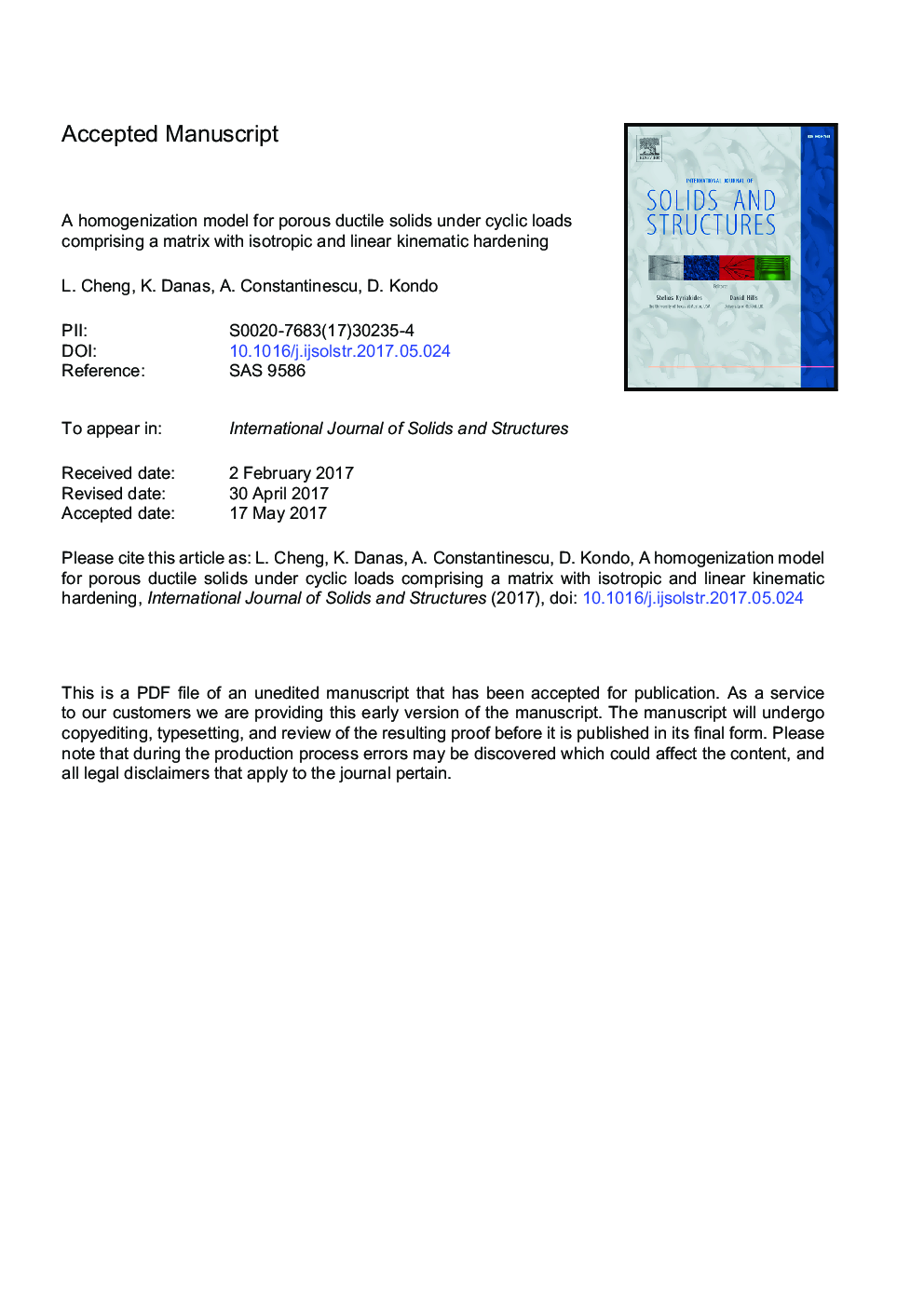| کد مقاله | کد نشریه | سال انتشار | مقاله انگلیسی | نسخه تمام متن |
|---|---|---|---|---|
| 4922315 | 1430182 | 2017 | 40 صفحه PDF | دانلود رایگان |
عنوان انگلیسی مقاله ISI
A homogenization model for porous ductile solids under cyclic loads comprising a matrix with isotropic and linear kinematic hardening
ترجمه فارسی عنوان
یک مدل همگن سازی برای جامدات متخلخل مجذور تحت بارهای سیکل شامل یک ماتریس با سخت شدن سینماتیک ایزوتروپیک و خطی
دانلود مقاله + سفارش ترجمه
دانلود مقاله ISI انگلیسی
رایگان برای ایرانیان
کلمات کلیدی
ترجمه چکیده
در این کار، ما یک مدل میکرومکانیکی نیمه تحلیلی را برای بررسی پاسخ الاستوپلاستیکی مواد متخلخل تحت بارگذاری چرخه ای با سخت شدن سینماتیک ایزوتروپیک و خطی در سویه های محدود ارائه می دهیم. برای این منظور، ما از یک تقسیم راهبرد همگن شدن تقسیم شده اما عددی کارایی بین قطعات الاستیک و پلاستیکی استفاده می کنیم. استرس برگشتی موثر در جامد متخلخل، شبیه به استرس ماکروسکوپیک و فشار پلاستیک، دارای شرایط هیدرواستاتیکی غیر صفر است و بستگی به تخلخل، شکل خام و جهت گیری در نتیجه فرآیند همگن شدن دارد. در ادامه، یک مجموعه کامل معادلات برای توصیف تکامل میکروارگانیسم، یعنی تخلخل حجم (تخلخل)، (بیضوی) و شکل خالص و جهت هر دو در رژیم های الاستیک و پلاستیک تعریف شده است. سپس مدل به صورت عددی در یک زیرمجموعه کاربر به طور کلی اجرا می شود. برای بررسی پیش بینی مدل پیشنهادی، فیلد کامل فیلدهای محدود از سلول واحد چندگانه خالی استفاده می شود. یافته های اخیر نشان می دهد که توافق کیفی و کمی با نتایج عناصر محدود برای اکثر انواع بارگذاری، پارامترهای سخت شدن و تخلخل های مورد نظر در این تحقیق است، اما برای تخلخل های بسیار کوچک است. مطالعات تحلیلی و عددی ترکیبی نشان می دهد که کشش یک مکانیسم مهمی برای کشیدن تخلخل علاوه بر سخت شدن کششی است. به طور خاص، به منظور بازیابی ویژگی های کیفی تراکم تخلخل برای تمام بارهای چرخه ای که در مطالعه حاضر مورد توجه قرار گرفته است، نشان داده شده است که برای تحول ریزساختار نه تنها در طول بارگذاری پلاستیک، بلکه به عنوان فرضیه معمول ، بلکه در طول بارگذاری الاستیک. در نهایت، اثر سختی سینماتیک ایزوتروپیک و خطی به نظر می رسد که اغلب موارد مورد بررسی در اینجا بسیار غیر مونوتونی و غیر ارادی بر روی تراکم تخلخل است.
موضوعات مرتبط
مهندسی و علوم پایه
سایر رشته های مهندسی
مهندسی عمران و سازه
چکیده انگلیسی
In this work, we propose a semi-analytical micromechanical model to study the elasto-plastic response of porous materials subjected to cyclic loading with isotropic and linear kinematic hardening at finite strains. To this end, we use an approximate but numerically efficient decoupled homogenization strategy between the elastic and plastic parts. The resulting effective back stress in the porous solid, similar to the macroscopic stress and plastic strain, has non-zero hydrostatic terms and depends on the porosity, the void shape and orientation as a result of the homogenization process. Subsequently, a complete set of equations is defined to describe the evolution of the microstructure, i.e., void volume fraction (porosity), (ellipsoidal) void shape and orientation both in the elastic and the plastic regimes. The model is then numerically implemented in a general purpose user-material subroutine. Full field finite element simulations of multi-void periodic unit cells are used to assess the predictions of the proposed model. The latter is found to be in good qualitative and quantitative agreement with the finite element results for most of the loading types, hardening parameters and porosities considered in this study, but is less accurate for very small porosities. The combined analytical and numerical study shows that elasticity is an important mechanism for porosity ratcheting in addition to strain hardening. Specifically, in order to recover the main qualitative features of porosity ratcheting for all cyclic loads considered in the present study, it is shown to be critical to take into account the evolution of the microstructure not only during the plastic loading, as is the usual hypothesis, but also during elastic loading. Finally, the effect of isotropic and linear kinematic hardening is found to be highly non-monotonic and non-trivial upon porosity ratcheting for most cases considered here.
ناشر
Database: Elsevier - ScienceDirect (ساینس دایرکت)
Journal: International Journal of Solids and Structures - Volume 121, 15 August 2017, Pages 174-190
Journal: International Journal of Solids and Structures - Volume 121, 15 August 2017, Pages 174-190
نویسندگان
L. Cheng, K. Danas, A. Constantinescu, D. Kondo,
